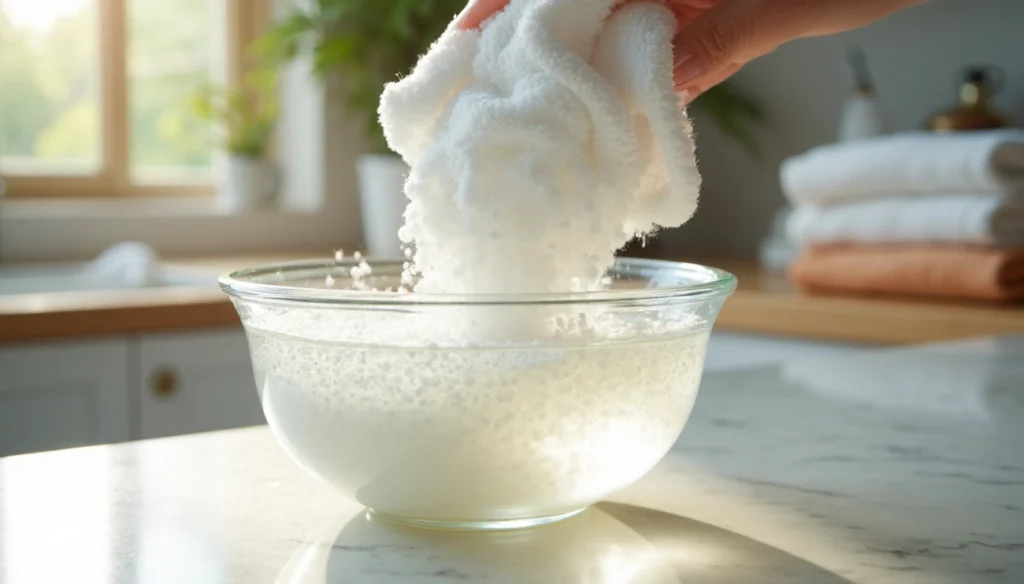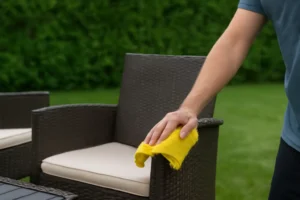Are you battling tough stains but concerned about using harsh chemicals on your clothes? You might wonder what is oxygen bleach powder and why more people choose this gentler option for their laundry. This natural yet powerful solution brightens whites and colors without damaging fabrics or hurting the environment, unlike its chlorine-based counterpart.
Oxygen bleach serves as a color-safe, non-chlorine cleaning agent that brightens laundry and removes stains. You can safely use it on almost all washable fabrics. People also know it as oxygen-based bleach or oxy bleach. This cleaner contains hydrogen peroxide or sodium percarbonate that releases oxygen once it dissolves in water. The powdered oxygen bleach creates a chemical reaction with water that releases oxygen bubbles. These bubbles lift away dirt and stains without chlorine’s harsh effects.
Oxygen bleach is a great way to get peace of mind if you worry about chemicals in your home. This non-toxic and biodegradable alternative breaks down into oxygen, water, and sodium carbonate after use. On top of that, it works great on organic stains. Coffee, tea, wine, food sauces, and stubborn grass stains that regular detergents can’t handle are no match for oxygen bleach.
What is Oxygen Bleach and How Does It Work?
Image Source: Amazon.com
Oxygen bleach combines simple chemistry with powerful cleaning abilities. People now prefer it over traditional bleaches because it’s gentler on clothes. Let me show you what makes this cleaner so effective and how it cleans your clothes.
What is oxygen bleach powder made of?
The main ingredient in oxygen bleach is sodium percarbonate – a mix of sodium carbonate (washing soda) and hydrogen peroxide. You’ll find this powder-based cleaner sometimes contains sodium perborate or hydrogen peroxide as its active ingredient. Most commercial “Oxy” products mix 35-40% sodium percarbonate with sodium carbonate. Manufacturers often add dyes, fragrances, or anti-caking agents to make the product work better and last longer.
How oxygen bleach activates in water
The cleaning action starts as soon as oxygen bleach touches water. The dry powder dissolves and goes through an oxidation process that releases its cleaning power. Sodium percarbonate breaks down and creates hydrogen peroxide, sodium cations, and carbonate. The hydrogen peroxide then turns into water and oxygen. These oxygen molecules create tiny cleaning bubbles that pull dirt and stains away from fabric fibers. The oxidation also helps remove built-up detergent and fabric softener that can make clothes stiff and dull.
Difference between oxygen bleach and chlorine bleach
Oxygen and chlorine bleaches serve the same purpose but work in different ways:
- Gentleness: Oxygen bleach treats fabrics and colors much more gently than chlorine bleach, so you can safely use it on most colored clothes.
- Speed and Power: Chlorine bleach removes stains and whitens faster, but oxygen bleach needs more time to work.
- Versatility: You can use oxygen bleach on many fabrics, even ones that say “Do Not Use Chlorine Bleach” because it won’t damage fibers or fade colors.
- Environmental Impact: Oxygen bleach breaks down into oxygen, water, and natural soda ash, which makes it biodegradable and septic-safe.
- Disinfecting Properties: Oxygen bleach can disinfect mildly but doesn’t sanitize as well as chlorine bleach.
Oxygen bleach gives you the best of both worlds – it cleans well and keeps your clothes safe, which makes it perfect for regular laundry use, especially for colored clothes.
Top Laundry Uses for Oxygen Bleach
Image Source: The Spruce
Let’s dive into how versatile oxygen bleach can be in your laundry room. This powerful yet gentle cleaner brightens dingy whites and rescues stained garments with amazing results.
Brightening whites and colors
Oxygen bleach transforms laundry by whitening whites and brightening colors without damaging your fabrics. Your whites stay brilliant and never look dingy. Tests show it whitens whites 40% better than chlorine bleach in each load. The brighteners it leaves behind help keep that crisp, clean look.
This cleaner can bring life back to fading colors. It works great on dingy sheets, especially when you have oily spots from pets. You’ll get the best brightening results by using oxygen bleach with the warmest water that’s safe for your fabric.
Removing tough stains from clothes
Regular detergents often fail with stubborn stains, but oxygen bleach handles them easily. It’s great at removing wine, coffee, blood, grease, and fruit juice stains.
Mix one tablespoon of oxygen bleach with a quart of water to pre-treat stains. Just dip the stained area in this solution before washing. You can also add it straight to your wash cycle to boost your detergent’s stain-fighting ability.
Eliminating odors from fabrics
Bad smells in textiles don’t stand a chance against oxygen bleach. Athletic wear comes clean because it lifts oils and odors from performance fabrics. Your musty towels will smell fresh again too.
Using oxygen bleach for delicate fabrics
Oxygen bleach packs cleaning power but stays gentle enough for most delicate fabrics. It’s perfect for items labeled “Do Not Use Chlorine Bleach”. Just test it on a hidden spot first to check colorfastness.
Your clothes stay safe while getting clean. Unlike chlorine bleach, it won’t damage fabric structure over time, so you can use it regularly on favorite garments.
How to Use Oxygen Bleach in Your Laundry Routine
Image Source: The Spruce
Ready to make oxygen bleach part of your laundry routine? Here’s how to make it work.
Using powdered oxygen bleach as a pre-soak
Oxygen bleach works wonders as a pre-soak to revive dingy fabrics and remove tough stains. Mix the right amount of powdered oxygen bleach in warm to hot water based on package instructions. Most brands work well with one tablespoon per gallon of water. Submerge your items and swirl them gently so the solution reaches all fibers. Since oxygen bleach takes time to work, let items soak for at least an hour. You’ll get the best results with stubborn stains by soaking for six to eight hours or overnight.
A wash basin or large bucket makes a great soaking container and keeps your sink or tub free. If you have a top-loading washer, you can pre-soak items right in the drum before washing.
Adding oxygen bleach to your washing machine
Both top and front-loading machines need powdered oxygen bleach added straight to the empty drum – not in dispensers or compartments. Note that oxygen bleach works alongside your regular detergent rather than replacing it. Add your usual detergent first, then the oxygen bleach, before putting in your laundry.
How much oxygen bleach to use per load
Load size and soil level determine the right amount. One tablespoon directly in the washing machine is enough for regular loads. Really dirty clothes might need two tablespoons to work better. Large commercial loads around 50 pounds may require 1-3 cups. The product packaging offers specific measurements – some brands have marked lines on their measuring tools.
Tips for using oxygen bleach in cold water
Warm or hot water brings out the best in oxygen bleach, but it can still work in cold cycles with a few tweaks. The powder might not dissolve well in very cold temperatures since it activates in water. The solution? Dissolve the oxygen bleach powder in a cup of hot water first, then add it to your cold wash. Liquid oxygen bleach formulas are another option as they dissolve more easily in cold water.
Whatever the water temperature, using too much oxygen bleach can leave chalky marks on clothes if they’re not rinsed well.
Safety Tips and When Not to Use Oxygen Bleach
Oxygen bleach offers many benefits, but you need to know its safety guidelines. A good understanding of this powerful cleaning agent’s proper use will help you protect your belongings and avoid unsafe situations.
Fabrics and materials to avoid
You should know that not all fabrics work well with oxygen bleach treatment. Never clean fine fabrics like silk and wool with oxygen bleach powder. The oxidizing properties can damage garments that have leather trim or wooden buttons, so stay away from using it on these materials.
Your colored fabrics are usually safe since oxygen bleach won’t strip dyes from fabrics, which makes it good for many colored clothes. Still, you should do a patch test on a hidden area before you use it fully. This helps ensure the colors won’t fade and the fabric won’t get damaged.
Why you shouldn’t mix it with other cleaners
Mixing oxygen bleach with other cleaning products puts you at risk. Never combine oxygen bleach with:
- Ammonia or chlorine bleach because they produce harmful gasses
- Other chemicals that aren’t made to work with oxygen bleach
- Vinegar, which can cause bad chemical reactions or make cleaning less effective
Wrong combinations can irritate your eyes, skin and breathing. The situation gets worse if you mix certain chemicals with bleach – they create toxic gasses called chloramines. These can make you cough, feel sick, struggle to breathe, and lead to serious health issues.
How to store oxygen bleach safely
The right storage keeps your oxygen bleach both effective and safe:
- Place it in a cool, dry spot where kids and pets can’t reach it
- Use proper labeled containers with tight lids
- Keep it away from heat sources, reducing agents, and anything that can burn
- Make sure your hands are dry before you handle it
- Don’t store it on wooden pallets
Remember that oxygen bleach dried on materials like rags, cloths, paper, or fabrics might catch fire on its own in certain conditions. Clean up any spills right away to stay safe.
Conclusion
Oxygen bleach is a remarkable cleaning solution that helps anyone who wants gentle yet effective laundry care. The simple chemistry behind this powerful alternative works by releasing oxygen bubbles to lift away dirt and stains. You’ll find it’s a more environmentally conscious choice for your household since it breaks down into harmless components after use, unlike chlorine bleach.
The most important advantage is that oxygen bleach works better than traditional bleaches. You can use it safely on colored fabrics and delicate materials (all but one of these materials – silk and wool), and it tackles stubborn organic stains from coffee, wine, and grass. On top of that, it fights odors that regular detergents can’t handle, which makes it perfect for refreshing towels and athletic wear.
Your success with oxygen bleach depends on how you use it. This powerful cleaner gives impressive results as a pre-soak for heavily soiled items or as a booster in your washing machine. Warm water helps it work best, though you can get good results in cold water by dissolving it first in hot water.
Your safety should come first with any cleaning product. Never mix oxygen bleach with other cleaners, especially ammonia or chlorine bleach. Keep it stored properly away from heat and moisture. These simple precautions will help make oxygen bleach a reliable part of your laundry routine.
The switch to oxygen bleach might seem small but brings huge benefits to your clothes, health, and the planet. People are becoming more aware of household chemicals, and this natural brightening alternative works well without harsh effects of traditional bleaches. Your whites stay brilliant, colors remain vibrant, and you’ll feel good knowing you’ve chosen a gentler way to clean your laundry.
FAQs
Q1. Is oxygen bleach safe for colored clothes?
Yes, oxygen bleach is generally safe for colored clothes. Unlike chlorine bleach, it won’t strip dyes from fabrics, making it suitable for brightening both whites and colors. However, it’s always a good idea to test on an inconspicuous area first to ensure colorfastness.
Q2. How long should I soak clothes in oxygen bleach?
For best results, soak clothes in an oxygen bleach solution for at least one hour. However, soaking for 6-8 hours or overnight is ideal for tackling stubborn stains and reviving dingy fabrics.
Q3. Can I use oxygen bleach in cold water?
Yes, you can use oxygen bleach in cold water, although it’s most effective in warm or hot water. To use in cold cycles, first dissolve the oxygen bleach powder in a cup of hot water before adding it to your cold wash. Alternatively, consider using liquid oxygen bleach formulations which dissolve more readily in cold water.
Q4. What types of stains does oxygen bleach work best on?
Oxygen bleach is particularly effective against organic stains such as wine, coffee, tea, blood, grease, and fruit juice. It’s also great for removing grass stains and other tough marks that regular detergents struggle with.
Q5. How much oxygen bleach should I use per load of laundry?
For a regular load, one tablespoon of oxygen bleach added directly to the washing machine is typically sufficient. For heavily soiled clothing, you can increase this to two tablespoons. Always check the product packaging for specific dosage instructions, as recommendations may vary between brands.




